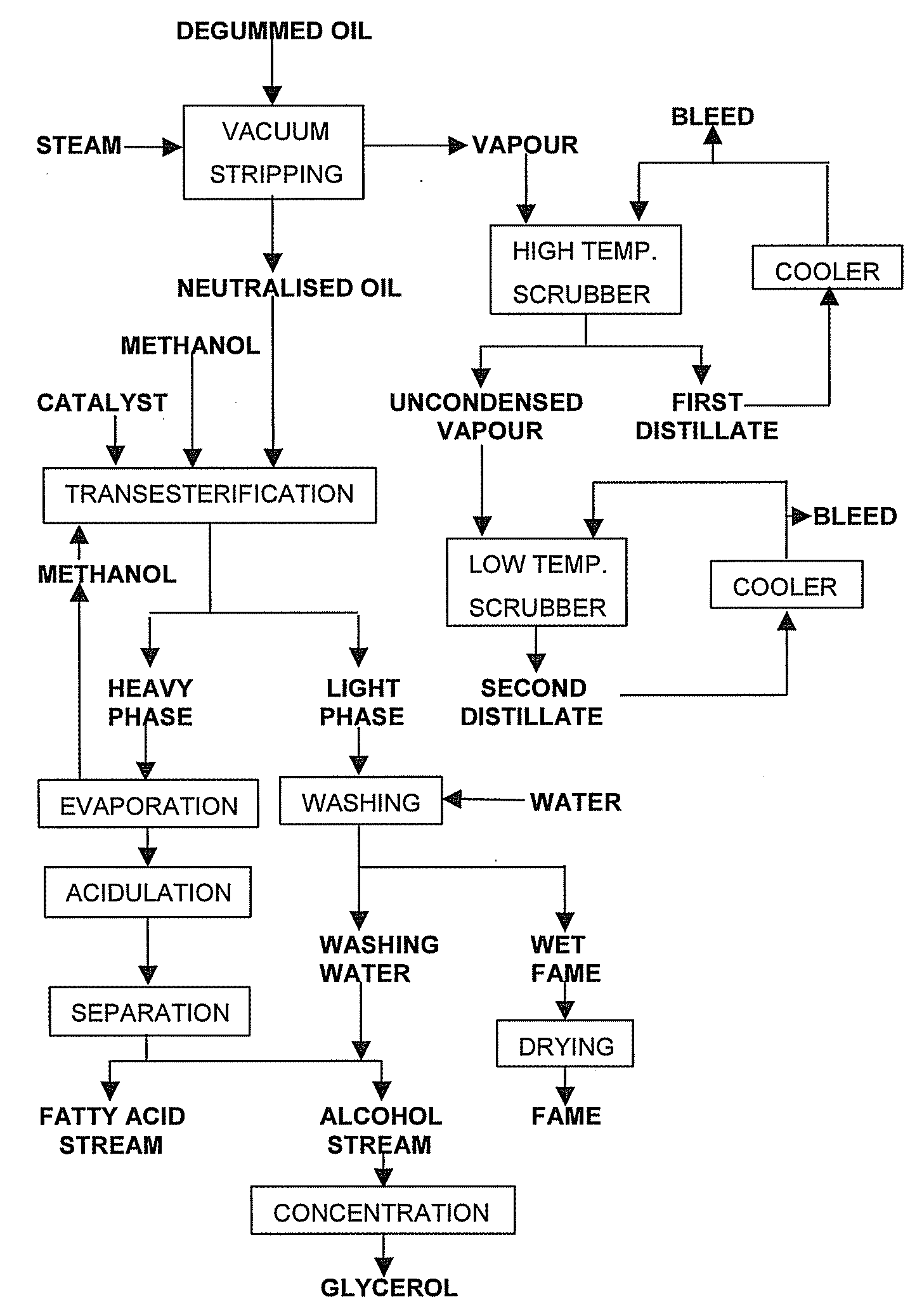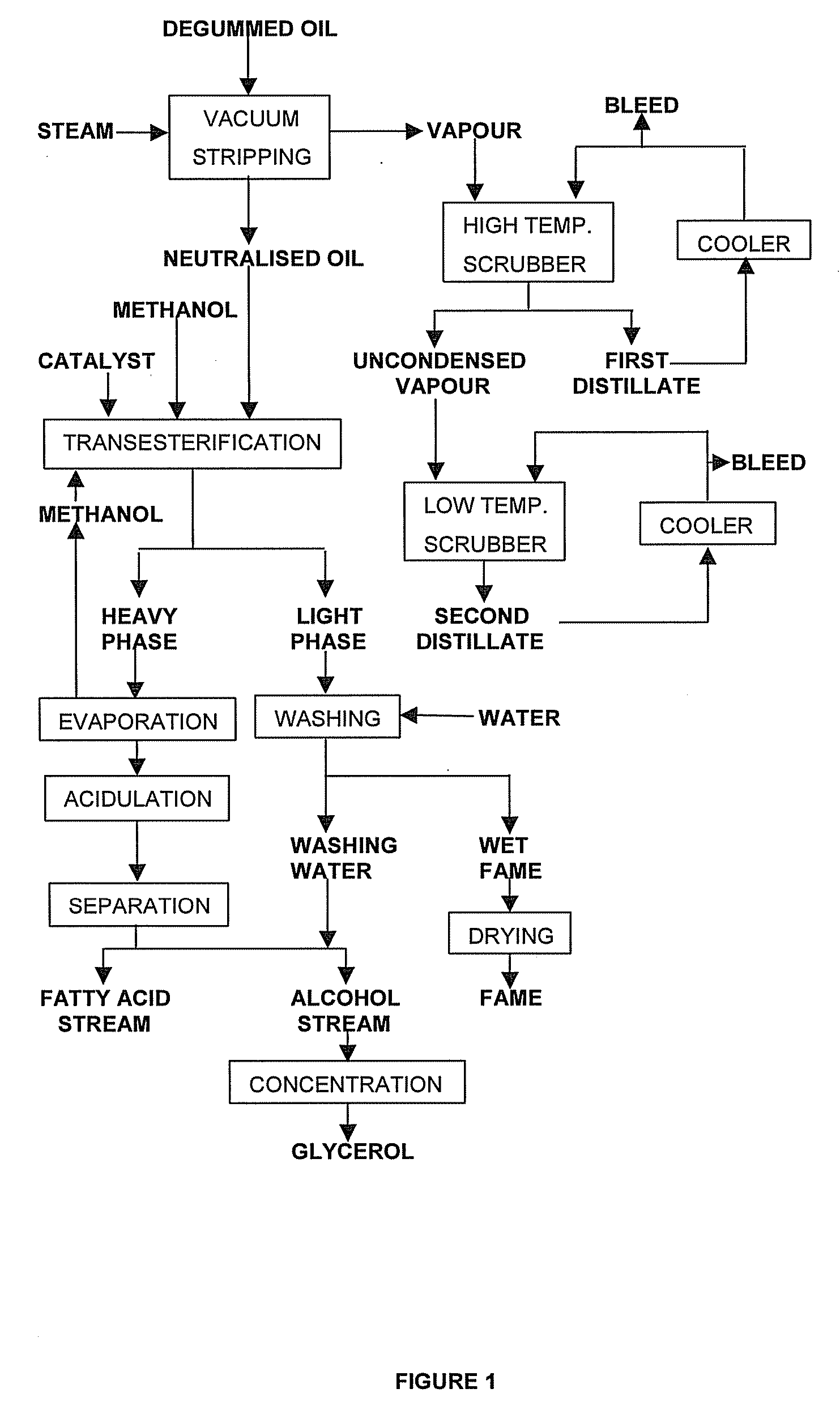Production of esters of fatty acids and lower alcohols
a technology of esters and fatty acids, applied in the field of production of esters of fatty acids and lower alcohols, can solve the problems of glycerolysis reaction, high temperature, and relatively slow reaction speed, and achieve the effect of reducing the number and/or the size of reaction vessels, avoiding harmful impurities, and maximizing the yield of fatty acid esters
- Summary
- Abstract
- Description
- Claims
- Application Information
AI Technical Summary
Benefits of technology
Problems solved by technology
Method used
Image
Examples
example 1
[0099] This example illustrates the preparation of a raw material by the acid refining process followed by the steam refining of the acid refined material. The raw material concerned is jatropha oil obtained in India from expelling the toxic physic nut (Jatropha curcas). Its fatty acid composition (by weight) was determined as comprising the following: palmitic acid, 16.0%; palmitoleic acid, 1,1%; stearic acid, 6.1%; oleic acid, 36.5%; linoleic acid, 39.9%; linolenic acid 0.2%. This composition makes the oil highly suitable for biodiesel.
[0100] The sample of jatropha oil used in this example had a FFA content of 4.7% (expressed as oleic acid) and contained 60.6 ppm phosphorus, 44.6 ppm iron, 36.4 ppm calcium and 21.4 ppm magnesium, as determined by inductively coupled plasma (ICP) spectroscopy. The citric acid refining process applied to the sample comprises the following steps: [0101] The oil is heated to 75° C.; [0102] An amount of 0.38% (wlw) of a 30% (w / w) solution of citric ac...
example 2
[0110] This example illustrates the preparation of a crude palm oil sample by the dry degumming process followed by de-acidification by vacuum stripping. The crude palm oil had a FFA content of 2.07 wt % (expressed as oleic acid) and a phosphorus content of 4.5 ppm. Accordingly, phosphorus removal was not required to prepare the sample for conversion into FAME by transesterification, but bleaching of the sample which contained 438 ppm β-carotene was considered to be desirable. Consequently, the dry degumming process which comprises the use of bleaching earth was chosen as means of preparation. It comprises the following steps: [0111] The oil is heated to 85° C.; [0112] An amount of 0.02% (w / w) of phosphoric acid of 85% strength is added to the oil and finely dispersed by using a high shear mixer for 1 minute; [0113] An amount of 0.5% (w / w) of distilled water is added and mixed into the acidified oil under gentle agitation; [0114] Bleaching earth (Tonsil Optimum 210 FF, commercially ...
example 3
[0118] This example illustrates the effect of scrubbing vapours in successive stages. For this purpose, a continuous vacuum stripping unit used for the physical refining of vegetable oil at a throughput of some 40 tonnes per hour was provided with two scrubbers in series. The unit comprised a packed column at the top for the removal of the main amount of FFA and underneath, a number of steam-sparged trays ensured proper deodorisation of the oil.
[0119] The soya bean oil used in this example had an FFA content of 1.5 wt % (expressed as oleic acid), a tocopherols content of 600 ppm, and a total sterol content of 4,000 ppm. However, some of the sterol esterified during the high temperature steam stripping process with free fatty acids present. This decreases their volatility and prevents their being removed from the oil being vacuum stripped. The content of non-esterified, free sterols of the soya bean oil-amounted to 3,000 ppm.
[0120] The oil to be vacuum stripped was heated to 260° C...
PUM
| Property | Measurement | Unit |
|---|---|---|
| temperature | aaaaa | aaaaa |
| stripping temperature | aaaaa | aaaaa |
| temperatures | aaaaa | aaaaa |
Abstract
Description
Claims
Application Information
 Login to View More
Login to View More - R&D
- Intellectual Property
- Life Sciences
- Materials
- Tech Scout
- Unparalleled Data Quality
- Higher Quality Content
- 60% Fewer Hallucinations
Browse by: Latest US Patents, China's latest patents, Technical Efficacy Thesaurus, Application Domain, Technology Topic, Popular Technical Reports.
© 2025 PatSnap. All rights reserved.Legal|Privacy policy|Modern Slavery Act Transparency Statement|Sitemap|About US| Contact US: help@patsnap.com



